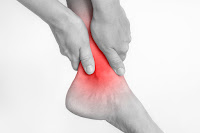Why does my ankle hurt??
What might have caused it?
 Foot and ankle injuries are very common in sports but are also caused by regular activities in your daily life. There are many structures, including bones, ligaments, cartilage and joint lining around the ankle that may be damaged as a result of an injury.
Foot and ankle injuries are very common in sports but are also caused by regular activities in your daily life. There are many structures, including bones, ligaments, cartilage and joint lining around the ankle that may be damaged as a result of an injury.Injuries can happen from a single traumatic event, from overuse, or from a previously untreated injury that manifests itself later in life. Joints like the ankle are designed to give our bodies freedom of movement, and any injury to them may alter your lifestyle.
Ankle Injury Symptoms
- Injuries may cause stiffness and pain in the foot or ankle joint, especially when you first get out of bed in the morning and start to walk around. The stiffness/pain will be present for a period of time proportional to the degree of injury in the joint.
- With weight-bearing, the joint usually loosens and the person is usually able to walk about or even run. Stiffness and pain will redevelop if the person sits for a period of time then tries to get back up and walk again.
- As the day continues the foot or ankle may begin to ache, especially with excessive weight bearing.
- Swelling may be present over the injured area.
- Instability may develop if the ligaments have been injured, causing the foot or ankle to constantly twist.
Ankle Injury Treatment
- When these injuries are unresponsive to conservative treatment (including orthotics, oral medication or injections, or rehabilitation) arthroscopic surgery may be necessary to remove the damaged tissue in the foot and ankle.
Ankle Arthroscopy Procedure
A miniature camera (between 1/8 and 1/6 inch) is placed into the injured joint and begins transmission to a television screen.The joint is visualized and small instruments, including a laser, are introduced into the affected area to clean out and repair the damage.
Often, surgery includes removal of bone and/or cartilage fragments. Following that, we suction debris and smooth rough surfaces, often allowing for a joint to resume its normal gliding motion.
If cartilage is torn, loose or lifted, it is removed and small holes (microfractures) are placed in the bone to allow a regrowth of the cartilage. Although not the original cartilage (hyaline) the resurfacing with fibrocartilage is beneficial. Biocartilage implantation may also be performed to transplant cadaver cartilage and provide scaffolding for cartilage regrowth.
Conditions Treated by Ankle Arthroscopy
- Chronic joint pain and swelling
- Arthritis and bone spurs
- Loose bone and cartilage fragments
- Stiff, scarred joints
- Chronic instability
- Ankle fractures that never fully healed and cause persistent stiffness
- Dancers Posterior Ankle Impingement "OS Trigonum" Syndrome
- Chronic Synovitis
Advantages of Ankle Arthroscopy
- Minimally invasive, with a faster recovery time
- Less pain and swelling
- Avoidance of large incisions and scars
- Lower risk of infection
- Outpatient procedure
- Quicker return to regular activities and sports
When conservative treatments fail to alleviate pain and deformity of a joint, arthroscopic surgery should be considered. The surgical procedure is especially helpful for a fracture in the ankle join even after the ankle joint has been fixed surgically. Cartilage in the ankle joint may have been damaged during injury and cause chronic stiffness and pain that may be mild but never completely goes away.
Patients often think this is a condition they can live with, however, once treated arthroscopically a full return to activity may be possible. It's always the best treatment option for athletes and dancers.




No comments:
Post a Comment